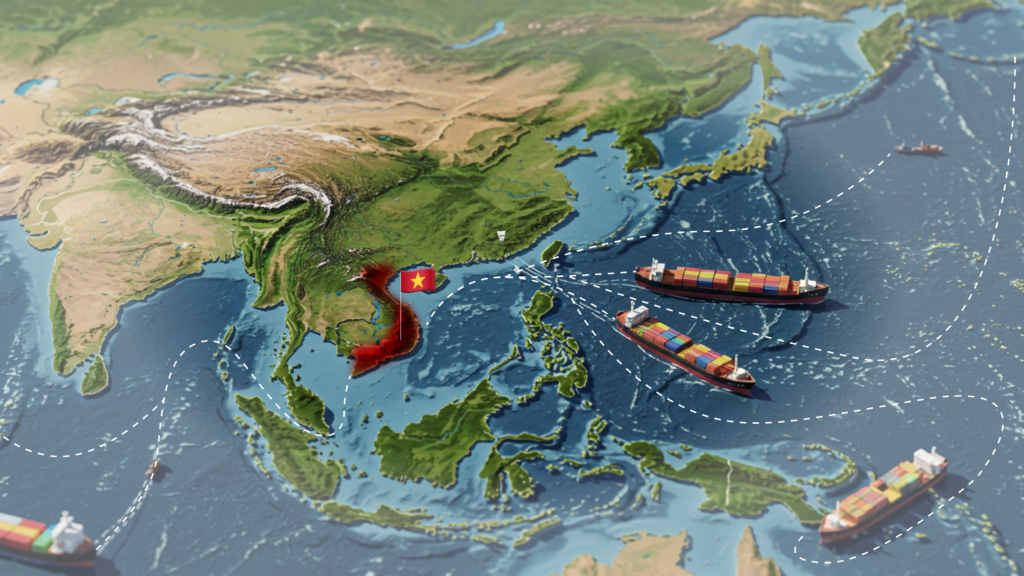By Move Supply Chain
DTC brands are rethinking everything — from margins to manufacturers.
Now, with tariffs on Chinese goods making headlines again — jumping as high as 100%+ in some categories — founders are feeling the heat.
Sourcing from China is no longer just a pricing game. It’s a risk management decision. And if you’re still relying on a single-country supply chain, you may be leaving your business vulnerable.
The smartest brands aren’t waiting for the next trade war, shipping disruption, or surprise duty hike to act. They’re taking steps now to diversify and strengthen their sourcing strategy — before the pressure hits.
Here’s how one health and wellness brand worked with Move Supply Chain to diversify into Vietnam, reduce lead times by 25 days, and save over $100,000 annually — all while increasing flexibility and protecting their margins.

The Challenge: Rising Costs, Supplier Risks, and Tariff Uncertainty
As demand for their products grew, this health-focused DTC brand was facing several supply chain issues:
- Long lead times (up to 60 days)
- High air freight and inspection costs
- Limited supplier diversity, leading to major risk exposure
- And now, renewed concerns around tariffs and China-dependency
They knew they needed to optimize costs and diversify beyond China — without compromising on quality or production timelines.

The Strategy: Expand Into Vietnam, Not Just China
The brand partnered with Move Supply Chain to run a dual-country sourcing sprint — with boots-on-the-ground supplier visits in both China and Vietnam.
Here are the results:
- 6 new vetted suppliers (3 in China, 3 in Vietnam)
- 80% massive logistics savings (shift from air to sea shipping)
- Factory audits to verify capabilities, compliance, and sustainability
- In-person negotiation for better pricing and production terms
- Replacement of underperforming suppliers

Why Vietnam?
Let’s take a step back. Why are more DTC brands looking to Vietnam?
As supply chains tighten and geopolitical risks rise, Vietnam has emerged as one of the most attractive alternatives to China for manufacturing — not just for cost savings, but for resilience, reliability, and long-term strategy.
Here’s why:
- Diversification Without Downgrading
Vietnam offers a high-quality, scalable manufacturing base for everything from CNC machining and packaging to wood and metal components. For DTC brands with growing SKUs or premium positioning, Vietnam checks the boxes. - Favorable Trade Conditions
Vietnam benefits from trade agreements and tariffs that are often less restrictive than those involving China. This can create significant cost advantages — especially in categories now affected by new U.S. tariffs. - Geographic Efficiency
Strategically located near key shipping routes, Vietnam makes it easier (and faster) to coordinate logistics across Asia. It’s also well-positioned to serve brands sourcing from or shipping to China, India, or Southeast Asia. - Growing Supplier Ecosystem
Vietnam’s manufacturing base continues to expand, with more factories upgrading capabilities to serve global clients. This includes low-MOQ suppliers, sustainability-forward factories, and vendors who are willing to work with early-stage or scaling brands.

Other Sourcing Alternatives
Of course, Vietnam isn’t the only option. India, Bangladesh, Indonesia, and Mexico are also gaining traction depending on the product category, speed-to-market needs, and brand values.
- India is ideal for textiles, leather goods, and complex handcrafts with strong compliance standards.
- Bangladesh offers competitive pricing for large-volume apparel and textiles.
- Indonesia is becoming a quiet powerhouse for eco-conscious production and smaller-batch goods.
- Mexico offers nearshoring benefits for North American brands needing faster turnaround and fewer time zones.
But for DTC brands balancing growth, quality, and long-term margin protection, Vietnam remains a top pick — especially for brands looking to stay agile, shift production outside of China, and establish multiple sourcing channels without sacrificing product integrity.
And here’s the key takeaway: you don’t need to wait for a crisis to make a smart move. Proactive DTC brands are already laying the groundwork now — while they still have options, time, and negotiating power on their side.

The Results: Faster Timelines, Stronger Margins, and Smarter Operations
The impact of diversifying suppliers across China and Vietnam was immediate — and measurable.
By investing in factory visits, direct negotiations, and supplier optimization, this DTC health brand achieved outcomes that strengthened both their supply chain and their bottom line:
- 20–25 days cut from production lead times
Faster turnaround meant fewer stockouts, better customer experience, and greater responsiveness to market demand. - $100,000+ in projected annual savings
Through more favorable pricing, reduced inspection fees, and smarter freight strategies, the brand significantly improved cost-efficiency. - 80.7% drop in logistics expenses
Transitioning from air to sea shipping dramatically reduced freight costs — while maintaining shipping reliability. - Improved product quality and reduced risk
By replacing underperforming suppliers, the brand avoided potential defects, returns, and reputation damage. - Healthier cash flow and operational flexibility
Shorter lead times and lower costs meant less cash trapped in inventory — and more room to invest in growth.
What This Means for You
If you’re sourcing from China and worried about what tariffs and trade changes might bring, now is the time to diversify.
Whether it’s Vietnam, India, or a hybrid of regions, the goal is clear: build a supply chain that works for you — not against you.
At Move Supply Chain, we help DTC brands connect with top-tier suppliers, conduct factory visits, negotiate better terms, and scale without the guesswork.
Need Help Future-Proofing Your Supply Chain?
If you’re ready to explore alternatives, reduce risk, and improve margins, we’re here to help.
Let’s talk about your next move.
